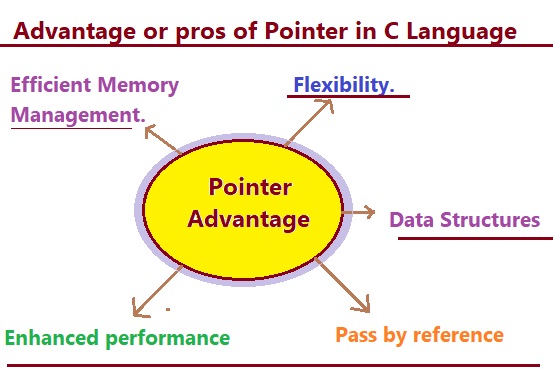Advantage or pros of pointer in c language.
In this tutorial section we are going to study the most important advantage or pros of pointer in C programming language.
In the C programming language, pointers offer several advantages, including:
A. Efficient memory management
B. Flexibility
C. Enhanced performance
D. Pass by reference
E. Data structures
A. Efficient memory management:
Pointers allow direct access to memory locations, enabling more efficient memory allocation and deallocation.
Efficient memory management with pointers in C includes the ability to directly access and manipulate memory locations. Using pointers, developers can allocate and deallocate memory, allowing more efficient use of memory resources.
Pointers enable the creation of data structures such as linked lists and trees that can be dynamically resized as needed. Additionally, pointers facilitate efficient data handling by providing direct access to memory locations, reducing the overhead associated with copying data. Overall, the use of pointers in C can lead to more efficient memory use and improved performance in memory-intensive applications.
B. Flexibility:
Pointers provide the ability to work with dynamic memory allocation, allowing for more flexible data structures and algorithms.
Pointers in C provide a high level of flexibility in data manipulation and memory management. With pointers, developers can dynamically allocate and deallocate memory, allowing them to create data structures that can grow or shrink as needed.
Pointers enable the use of complex data structures such as linked lists, trees, and graphs, and provide flexibility in storing and organizing data.
In addition, pointers allow efficient parameter passing by reference, and enable functions to modify variables outside their scope. These changes in data manipulation and memory management make pointers a powerful tool in C programming for creating more dynamic and efficient algorithms and data structures.
C. Enhanced performance:
By using pointers, developers can optimize code for better performance, especially in scenarios where direct memory access is required.
Pointers in C can enhance performance by providing direct access to memory locations, which can lead to optimized memory usage and faster data manipulation. By using pointers, developers can avoid unnecessary data copying and achieve more efficient memory management. Pointers also enable the implementation of complex data structures and algorithms, such as linked lists and trees, which can improve performance in certain scenarios. Additionally, pointers allow for pass-by-reference parameter passing, reducing the overhead of passing large data structures to functions. Overall, the use of pointers in C can contribute to enhanced performance by enabling more efficient memory access and manipulation.
D. Pass by reference:
Pointers enable functions to modify variables outside their scope by passing memory addresses, allowing for more efficient parameter passing.
In C language , pass by reference is achieved using pointers. When a function is called with arguments passed by reference, the memory address of the variable is passed to the function instead of the actual value. This allows the function to directly modify the original variable in memory, rather than working with a copy of the variable's value.
Passing arguments by reference using pointers in C can be beneficial for several reasons:
1. Efficiency: Passing large data structures by reference can be more efficient than passing them by value, as it avoids the need to create a copy of the data.
2. Modifying variables:
Functions can modify native or the original variables passed by reference, causing changes to be reflected outside the scope of the function.
3. Avoiding global variables: Pass by reference can be used to modify variables without the need for global variables, improving code modularity and encapsulation.
Overall, pass by reference using pointers in C provides a way to efficiently modify variables within functions and work with complex data structures without incurring the overhead of copying data.
E. Data Structures:
Pointers are important for implementing complex data structures such as linked lists, trees, and graphs, which provide efficient ways to store and manipulate data.
In C programs, pointers play an important role in the correct implementation of data structures. Some common data structures that can be used with pointers in C include:
1. Linked Lists: Linked lists are dynamic data structures where each element (node) has a data field and a pointer to the next node. Pointers are used to link nodes together, allowing efficient insertion, traversal, and deletion operations.
2. Trees: Binary trees, binary search trees and other tree-based data structures can be implemented in C using pointers. Pointers are used to establish parent-child relationships between nodes, enabling efficient search, insert, and delete operations.
3. Queues and Stacks: Queues and stacks are abstract data types in c programming language that can be implemented using pointers in C. Pointers are used to link elements together in a queue or stack structure, enabling FIFO (first-in-first-out) and LIFO (last-in-first-out). out) operations, respectively.
4. Graphs: Graphs have vertices and edges, and pointers can be used to represent these relationships in C. Pointer in C help in creating an adjacency list or matrix to store data and facilitate graph traversal algorithms.
By taking advantage of pointers in C, developers can create efficient and flexible data structures that can be dynamically changed and accessed, making them essential for building complex algorithms and applications.
Using pointers in C, developers can create powerful and flexible data structures that can be changed and accessed dynamically, making them essential for building complex applications and algorithms.
